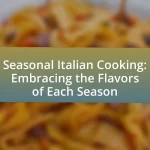The article focuses on incorporating Italian culinary techniques into everyday cooking, highlighting methods such as sautéing, braising, and pasta-making. It emphasizes the importance of fresh ingredients, simplicity, and regional diversity in Italian cuisine, which distinguishes it from other cooking styles. The article also discusses foundational principles of Italian cooking, the significance of specific cooking methods, and practical tips for adapting traditional techniques to modern recipes. Additionally, it outlines essential tools and ingredients for authentic Italian cooking, providing guidance on sourcing quality products and enhancing flavor and presentation in home-cooked meals.

What are Italian Culinary Techniques?
Italian culinary techniques encompass a variety of methods used in the preparation and cooking of Italian dishes, including sautéing, braising, roasting, and pasta-making. These techniques emphasize the use of fresh ingredients, regional flavors, and traditional practices that have been passed down through generations. For example, sautéing involves cooking food quickly in a small amount of oil over high heat, which is essential for developing flavors in dishes like risotto. Braising combines both moist and dry heat, often used for tougher cuts of meat, allowing them to become tender while absorbing rich flavors. Roasting is commonly applied to vegetables and meats, enhancing their natural sweetness and texture. Pasta-making, a cornerstone of Italian cuisine, involves techniques such as kneading and rolling dough to create various pasta shapes, which are often paired with specific sauces to highlight their unique characteristics. These techniques not only define Italian cooking but also reflect the cultural heritage and regional diversity of Italy.
How do Italian culinary techniques differ from other cooking styles?
Italian culinary techniques emphasize simplicity, quality ingredients, and traditional methods, distinguishing them from other cooking styles. For instance, Italian cuisine often prioritizes fresh, seasonal produce and regional specialties, which contrasts with more globalized cooking styles that may rely on processed ingredients. Additionally, techniques such as slow cooking, sautéing, and the use of olive oil as a primary fat are hallmarks of Italian cooking, whereas other cuisines might favor different fats or quicker cooking methods. This focus on technique and ingredient integrity is rooted in Italy’s rich culinary history, where meals are often prepared with a deep respect for tradition and local flavors.
What are the foundational principles of Italian cooking?
The foundational principles of Italian cooking include simplicity, quality ingredients, and regional diversity. Simplicity emphasizes using a few high-quality ingredients to create flavorful dishes, reflecting the Italian belief that less is more. Quality ingredients are paramount, as fresh, seasonal produce, high-quality olive oil, and artisanal cheeses enhance the overall taste and authenticity of the cuisine. Regional diversity showcases the unique culinary traditions across Italy’s various regions, each contributing distinct flavors and techniques, such as the use of seafood in coastal areas and hearty meats in the north. These principles are rooted in Italy’s culinary history, where local ingredients and traditional methods have shaped the nation’s cooking style over centuries.
How do regional variations influence Italian culinary techniques?
Regional variations significantly influence Italian culinary techniques by dictating the ingredients, cooking methods, and flavor profiles unique to each area. For instance, northern regions like Lombardy and Veneto emphasize creamy risottos and polenta, while southern regions such as Sicily and Calabria focus on tomato-based sauces and fresh seafood. This diversity stems from historical agricultural practices, local climate conditions, and cultural exchanges, which have shaped the availability of ingredients and traditional cooking methods. The use of specific herbs, cheeses, and meats varies widely; for example, basil is prevalent in the south, while butter is more common in the north. These regional distinctions not only reflect local tastes but also preserve culinary heritage, making Italian cuisine a rich tapestry of techniques influenced by geography and tradition.
Why are Italian culinary techniques important in everyday cooking?
Italian culinary techniques are important in everyday cooking because they emphasize fresh ingredients, simplicity, and flavor enhancement. These techniques, such as sautéing, braising, and using herbs, allow home cooks to create dishes that are both delicious and nutritious. For instance, the Italian method of using high-quality olive oil not only adds flavor but also provides health benefits, as it is rich in monounsaturated fats and antioxidants. Additionally, the focus on seasonal produce encourages sustainable cooking practices, which can lead to better meal quality and reduced environmental impact.
What benefits do these techniques bring to home cooking?
Italian culinary techniques enhance home cooking by improving flavor, texture, and presentation of dishes. These methods, such as proper seasoning, slow cooking, and the use of fresh ingredients, elevate the overall quality of meals. For instance, techniques like sautéing and braising allow for deeper flavor development, while the emphasis on fresh herbs and vegetables promotes healthier eating. Additionally, mastering these techniques can increase a cook’s confidence and creativity in the kitchen, leading to more enjoyable cooking experiences.
How can mastering these techniques enhance flavor and presentation?
Mastering Italian culinary techniques enhances flavor and presentation by allowing cooks to utilize methods that elevate the quality of ingredients and the visual appeal of dishes. Techniques such as proper seasoning, emulsification, and the use of fresh herbs can intensify flavors, making dishes more vibrant and enjoyable. For example, the technique of sautéing vegetables at the right temperature preserves their natural sweetness and color, resulting in a more appealing dish. Additionally, mastering plating techniques, such as layering and garnishing, creates visually stunning presentations that enhance the dining experience. Studies show that visually appealing food can increase perceived taste and enjoyment, reinforcing the importance of presentation in culinary arts.

How can you incorporate Italian culinary techniques into your cooking?
To incorporate Italian culinary techniques into your cooking, focus on mastering foundational methods such as sautéing, braising, and making fresh pasta. Sautéing involves cooking ingredients quickly in a small amount of oil over high heat, which enhances flavors and textures, a technique widely used in Italian cuisine for dishes like risotto. Braising combines both moist and dry heat, allowing tougher cuts of meat to become tender and flavorful, exemplified in dishes like osso buco. Making fresh pasta from scratch, using flour and eggs, is a hallmark of Italian cooking that elevates the quality of dishes like fettuccine and ravioli. These techniques not only improve the authenticity of your meals but also align with the Italian culinary philosophy of using high-quality, fresh ingredients to create simple yet delicious dishes.
What are some basic Italian cooking techniques to start with?
Basic Italian cooking techniques include sautéing, simmering, and making fresh pasta. Sautéing involves cooking food quickly in a small amount of oil over high heat, which enhances flavors and textures. Simmering is a gentle cooking method that allows ingredients to cook slowly in liquid, often used for sauces and soups, ensuring a rich depth of flavor. Making fresh pasta involves mixing flour and eggs to create a dough, which is then rolled out and cut into various shapes, providing a foundation for many Italian dishes. These techniques are fundamental in Italian cuisine and are essential for creating authentic flavors.
How do you properly use fresh ingredients in Italian cooking?
To properly use fresh ingredients in Italian cooking, prioritize seasonal produce and quality selection. Fresh ingredients should be handled minimally to preserve their natural flavors; for example, tomatoes should be used raw in salads or lightly cooked in sauces to maintain their freshness. The Italian culinary tradition emphasizes the importance of simplicity, often using just a few fresh ingredients to create vibrant dishes, such as Caprese salad, which features ripe tomatoes, fresh mozzarella, and basil. This approach is validated by the Mediterranean diet, which highlights the health benefits of consuming fresh, whole foods.
What is the significance of cooking methods like sautéing and braising?
Sautéing and braising are significant cooking methods in Italian cuisine due to their ability to enhance flavor and texture in dishes. Sautéing involves cooking food quickly in a small amount of fat over high heat, which caramelizes the ingredients and intensifies their natural flavors. This method is ideal for vegetables and proteins, allowing for a quick preparation while retaining nutrients. Braising, on the other hand, combines both dry and moist heat, typically starting with browning the food and then cooking it slowly in liquid. This technique tenderizes tougher cuts of meat and infuses them with rich flavors from the cooking liquid, making it essential for hearty Italian dishes like osso buco. Both methods are foundational in Italian cooking, contributing to the depth and complexity of flavors that characterize the cuisine.
How can you adapt Italian techniques to modern recipes?
You can adapt Italian techniques to modern recipes by incorporating traditional methods such as slow cooking, fresh ingredient emphasis, and simple flavor combinations while utilizing contemporary cooking tools and techniques. For instance, using sous-vide to achieve precise temperature control can enhance the tenderness of meats traditionally braised in Italian cuisine. Additionally, integrating fresh herbs and seasonal vegetables, which are staples in Italian cooking, into modern dishes can elevate flavors without complicating the preparation process. This approach aligns with the Italian culinary philosophy of prioritizing quality ingredients and straightforward cooking methods, making it relevant for today’s health-conscious and time-efficient cooking styles.
What are some examples of traditional recipes that can be modernized?
Examples of traditional recipes that can be modernized include risotto, lasagna, and tiramisu. Risotto can be updated by incorporating quinoa or cauliflower rice for a healthier twist, while lasagna can be modernized by using zucchini or eggplant slices instead of pasta sheets, catering to gluten-free diets. Tiramisu can be reimagined by substituting traditional coffee with matcha or using dairy-free mascarpone alternatives, appealing to vegan preferences. These adaptations maintain the essence of the original dishes while aligning with contemporary dietary trends.
How can you balance authenticity with contemporary dietary preferences?
To balance authenticity with contemporary dietary preferences, one can adapt traditional Italian recipes by incorporating modern ingredients and cooking methods while maintaining the essence of the original dish. For example, using whole grains instead of refined pasta or substituting dairy with plant-based alternatives allows for healthier options that align with current dietary trends without losing the foundational flavors of Italian cuisine. This approach is supported by the increasing popularity of Mediterranean diets, which emphasize fresh, seasonal ingredients and have been shown to improve health outcomes, as evidenced by research published in the New England Journal of Medicine, which highlights the benefits of such diets in reducing cardiovascular risks.

What tools and ingredients are essential for Italian cooking?
Essential tools for Italian cooking include a chef’s knife, cutting board, pasta maker, and a heavy-bottomed pot. These tools facilitate the preparation of traditional dishes, such as pasta and sauces. Key ingredients consist of high-quality olive oil, fresh herbs like basil and oregano, garlic, tomatoes, and Parmigiano-Reggiano cheese. These ingredients are foundational in Italian cuisine, contributing to authentic flavors and textures. For instance, olive oil is a staple fat used in cooking and dressing, while tomatoes are crucial for sauces and salads, reflecting the Mediterranean diet’s emphasis on fresh produce.
What kitchen tools are commonly used in Italian cuisine?
Common kitchen tools used in Italian cuisine include a pasta maker, a mortar and pestle, and a mandoline slicer. The pasta maker is essential for rolling and cutting fresh pasta, which is a staple in Italian dishes. The mortar and pestle are used for grinding herbs and spices, allowing for the creation of authentic sauces and marinades. The mandoline slicer provides uniform cuts for vegetables, ensuring even cooking and presentation in dishes like ratatouille or caponata. These tools are integral to achieving traditional Italian flavors and textures in cooking.
How do specific tools enhance the cooking process?
Specific tools enhance the cooking process by improving efficiency, precision, and consistency in food preparation. For example, a mandoline slicer allows for uniform slicing of vegetables, which not only enhances presentation but also ensures even cooking, as noted in culinary studies that emphasize the importance of uniformity in cooking times. Additionally, using a digital kitchen scale provides accurate measurements, which is crucial in Italian cooking where ingredient ratios can significantly affect the final dish, as supported by research from the Culinary Institute of America that highlights the role of precise measurements in achieving authentic flavors. Thus, the right tools streamline tasks, reduce preparation time, and contribute to the overall quality of the cooking process.
What are the must-have ingredients for Italian cooking?
The must-have ingredients for Italian cooking include olive oil, garlic, tomatoes, basil, and Parmesan cheese. Olive oil serves as a primary cooking fat and flavor enhancer, while garlic adds depth to many dishes. Tomatoes, particularly San Marzano varieties, are essential for sauces and stews. Fresh basil provides aromatic flavor, and Parmesan cheese is a key ingredient for adding richness and umami to various recipes. These ingredients are foundational in traditional Italian cuisine, reflecting the emphasis on fresh, high-quality components that characterize the culinary style.
How can you source authentic Italian ingredients?
To source authentic Italian ingredients, purchase from reputable Italian specialty stores or directly from Italian producers. These stores often import high-quality products such as San Marzano tomatoes, Parmigiano-Reggiano cheese, and extra virgin olive oil, ensuring authenticity. Additionally, online platforms like Eataly and Italian Food Online offer a wide selection of genuine Italian ingredients, often sourced from specific regions in Italy known for their culinary heritage. According to the Italian Trade Agency, products labeled with DOP (Denominazione di Origine Protetta) or IGP (Indicazione Geografica Protetta) guarantee authenticity and adherence to traditional production methods.
What are the best places to find quality Italian products?
The best places to find quality Italian products include specialty Italian grocery stores, online retailers specializing in Italian goods, and local farmers’ markets that feature Italian imports. Specialty Italian grocery stores, such as Eataly and Di Palo’s Fine Foods, offer a wide range of authentic Italian ingredients, including pasta, olive oil, and cheeses. Online retailers like Amazon and Italian Food Online provide access to a variety of Italian products that may not be available locally. Additionally, local farmers’ markets often have vendors who import high-quality Italian products, ensuring freshness and authenticity. These sources are recognized for their commitment to quality and authenticity in Italian culinary products.
How can you identify authentic Italian ingredients when shopping?
To identify authentic Italian ingredients when shopping, look for certifications such as DOP (Denominazione di Origine Protetta) or IGP (Indicazione Geografica Protetta), which guarantee that products are produced in specific regions of Italy using traditional methods. For example, Parmigiano-Reggiano cheese must be made in certain provinces of Italy and adhere to strict production standards. Additionally, check for labels indicating the use of high-quality olive oil, such as extra virgin, and inspect the ingredient list for authenticity, avoiding products with artificial additives or preservatives.
What are some practical tips for incorporating Italian techniques into daily meals?
To incorporate Italian techniques into daily meals, focus on using fresh, high-quality ingredients and traditional cooking methods. Start by sourcing seasonal vegetables, herbs, and proteins, as Italian cuisine emphasizes the use of local and fresh produce. Techniques such as sautéing garlic in olive oil to build flavor, using a slow simmer for sauces to enhance depth, and incorporating fresh herbs like basil and parsley at the end of cooking can elevate dishes. Additionally, mastering the art of pasta making, whether fresh or dried, allows for a more authentic Italian experience. These practices are rooted in Italian culinary tradition, which values simplicity and quality, ensuring that meals are both flavorful and satisfying.















